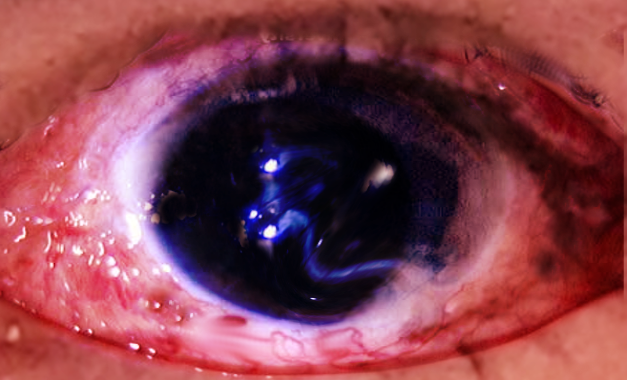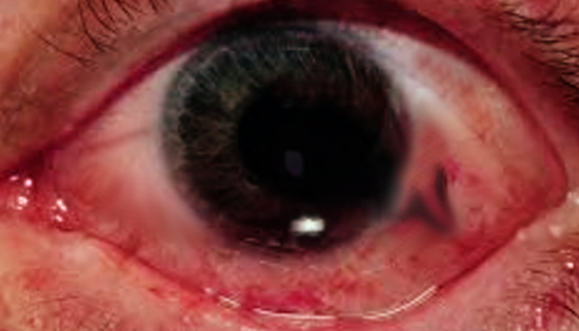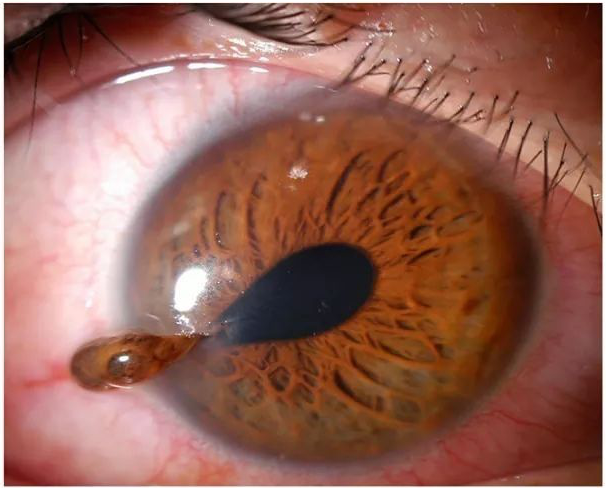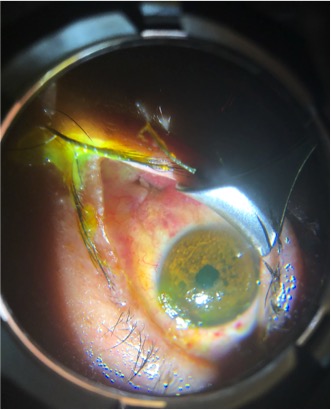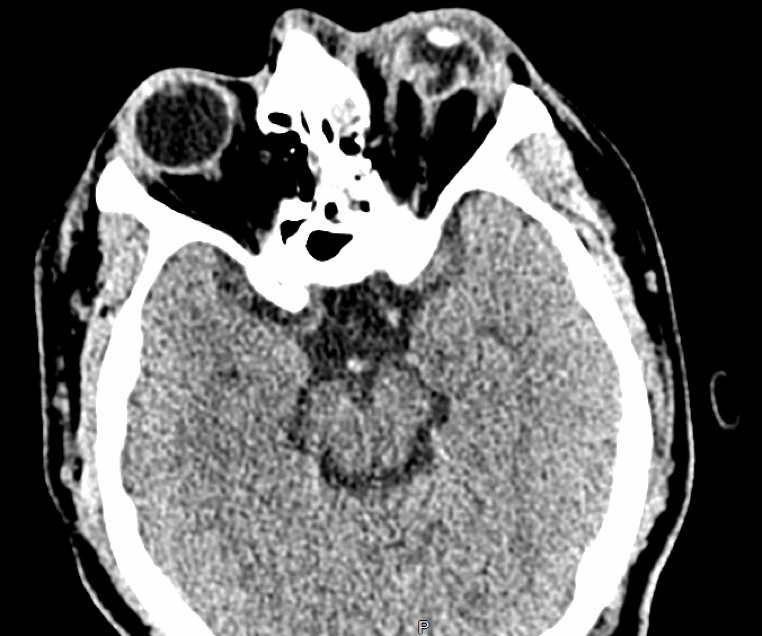[1]
Li X, Zarbin MA, Bhagat N. Pediatric open globe injury: A review of the literature. Journal of emergencies, trauma, and shock. 2015 Oct-Dec:8(4):216-23. doi: 10.4103/0974-2700.166663. Epub
[PubMed PMID: 26604528]
[2]
Thompson CG, Kumar N, Billson FA, Martin F. The aetiology of perforating ocular injuries in children. The British journal of ophthalmology. 2002 Aug:86(8):920-2
[PubMed PMID: 12140216]
[3]
Hughes E, Fahy G. A 24-month review of globe rupture in a tertiary referral hospital. Irish journal of medical science. 2020 May:189(2):723-726. doi: 10.1007/s11845-019-02097-2. Epub 2019 Sep 13
[PubMed PMID: 31520281]
[4]
Andreoli MT, Andreoli CM. Geriatric traumatic open globe injuries. Ophthalmology. 2011 Jan:118(1):156-9. doi: 10.1016/j.ophtha.2010.04.034. Epub 2010 Aug 14
[PubMed PMID: 20709403]
[5]
Li L, Lu H, Ma K, Li YY, Wang HY, Liu NP. Etiologic Causes and Epidemiological Characteristics of Patients with Intraocular Foreign Bodies: Retrospective Analysis of 1340 Cases over Ten Years. Journal of ophthalmology. 2018:2018():6309638. doi: 10.1155/2018/6309638. Epub 2018 Jan 31
[PubMed PMID: 29651344]
Level 2 (mid-level) evidence
[6]
Ben Simon GJ, Moisseiev J, Rosen N, Alhalel A. Gunshot wound to the eye and orbit: a descriptive case series and literature review. The Journal of trauma. 2011 Sep:71(3):771-8; discussion 778. doi: 10.1097/TA.0b013e3182255315. Epub
[PubMed PMID: 21909007]
Level 2 (mid-level) evidence
[7]
Cass SP. Ocular injuries in sports. Current sports medicine reports. 2012 Jan-Feb:11(1):11-5. doi: 10.1249/JSR.0b013e318240dc06. Epub
[PubMed PMID: 22236819]
[8]
Born CT. Blast trauma: the fourth weapon of mass destruction. Scandinavian journal of surgery : SJS : official organ for the Finnish Surgical Society and the Scandinavian Surgical Society. 2005:94(4):279-85
[PubMed PMID: 16425623]
[9]
Koo L, Kapadia MK, Singh RP, Sheridan R, Hatton MP. Gender differences in etiology and outcome of open globe injuries. The Journal of trauma. 2005 Jul:59(1):175-8
[PubMed PMID: 16096559]
[10]
Kumar K, Figurasin R, Kumar S, Waseem M. An Uncommon Meridional Globe Rupture due to Blunt Eye Trauma. Case reports in emergency medicine. 2018:2018():1808509. doi: 10.1155/2018/1808509. Epub 2018 Sep 18
[PubMed PMID: 30319823]
Level 3 (low-level) evidence
[11]
Wong TY, Klein BE, Klein R. The prevalence and 5-year incidence of ocular trauma. The Beaver Dam Eye Study. Ophthalmology. 2000 Dec:107(12):2196-202
[PubMed PMID: 11097595]
[12]
Bisplinghoff JA, McNally C, Duma SM. High-rate internal pressurization of human eyes to predict globe rupture. Archives of ophthalmology (Chicago, Ill. : 1960). 2009 Apr:127(4):520-3. doi: 10.1001/archophthalmol.2008.614. Epub
[PubMed PMID: 19365034]
[14]
Couperus K, Zabel A, Oguntoye MO. Open Globe: Corneal Laceration Injury with Negative Seidel Sign. Clinical practice and cases in emergency medicine. 2018 Aug:2(3):266-267. doi: 10.5811/cpcem.2018.4.38086. Epub 2018 Jun 12
[PubMed PMID: 30083651]
Level 3 (low-level) evidence
[15]
Yuan WH, Hsu HC, Cheng HC, Guo WY, Teng MM, Chen SJ, Lin TC. CT of globe rupture: analysis and frequency of findings. AJR. American journal of roentgenology. 2014 May:202(5):1100-7. doi: 10.2214/AJR.13.11010. Epub
[PubMed PMID: 24758666]
[16]
Chou C, Lou YT, Hanna E, Huang SH, Lee SS, Lai HT, Chang KP, Wang HM, Chen CW. Diagnostic performance of isolated orbital CT scan for assessment of globe rupture in acute blunt facial trauma. Injury. 2016 May:47(5):1035-41. doi: 10.1016/j.injury.2016.01.014. Epub 2016 Jan 25
[PubMed PMID: 26944178]
[17]
Modjtahedi BS, Rong A, Bobinski M, McGahan J, Morse LS. Imaging characteristics of intraocular foreign bodies: a comparative study of plain film X-ray, computed tomography, ultrasound, and magnetic resonance imaging. Retina (Philadelphia, Pa.). 2015 Jan:35(1):95-104. doi: 10.1097/IAE.0000000000000271. Epub
[PubMed PMID: 25090044]
Level 2 (mid-level) evidence
[18]
Ritson JE, Welch J. The management of open globe eye injuries: a discussion of the classification, diagnosis and management of open globe eye injuries. Journal of the Royal Naval Medical Service. 2013:99(3):127-30
[PubMed PMID: 24511795]
[19]
Bord SP, Linden J. Trauma to the globe and orbit. Emergency medicine clinics of North America. 2008 Feb:26(1):97-123, vi-vii. doi: 10.1016/j.emc.2007.11.006. Epub
[PubMed PMID: 18249259]
[20]
Iyer MN, Kranias G, Daun ME. Post-traumatic endophthalmitis involving Clostridium tetani and Bacillus spp. American journal of ophthalmology. 2001 Jul:132(1):116-7
[PubMed PMID: 11438069]
[21]
Lorch A, Sobrin L. Prophylactic antibiotics in posttraumatic infectious endophthalmitis. International ophthalmology clinics. 2013 Fall:53(4):167-76. doi: 10.1097/IIO.0b013e3182a12a1b. Epub
[PubMed PMID: 24088943]
[22]
Bower T, Samek DA, Mohammed A, Mohammed A, Kasner P, Camoriano D, Kasner O. Systemic medication usage in glaucoma patients. Canadian journal of ophthalmology. Journal canadien d'ophtalmologie. 2018 Jun:53(3):242-245. doi: 10.1016/j.jcjo.2017.10.029. Epub 2018 Feb 1
[PubMed PMID: 29784160]
[23]
Agrawal R, Rao G, Naigaonkar R, Ou X, Desai S. Prognostic factors for vision outcome after surgical repair of open globe injuries. Indian journal of ophthalmology. 2011 Nov-Dec:59(6):465-70. doi: 10.4103/0301-4738.86314. Epub
[PubMed PMID: 22011491]
[24]
Zhang Y, Zhang MN, Jiang CH, Yao Y, Zhang K. Endophthalmitis following open globe injury. The British journal of ophthalmology. 2010 Jan:94(1):111-4. doi: 10.1136/bjo.2009.164913. Epub 2009 Aug 18
[PubMed PMID: 19692359]
[25]
Thevi T, Abas AL. Role of intravitreal/intracameral antibiotics to prevent traumatic endophthalmitis - Meta-analysis. Indian journal of ophthalmology. 2017 Oct:65(10):920-925. doi: 10.4103/ijo.IJO_512_17. Epub
[PubMed PMID: 29044054]
Level 1 (high-level) evidence
[26]
Narang S, Gupta V, Gupta A, Dogra MR, Pandav SS, Das S. Role of prophylactic intravitreal antibiotics in open globe injuries. Indian journal of ophthalmology. 2003 Mar:51(1):39-44
[PubMed PMID: 12701861]
[27]
Yeh S, Colyer MH, Weichel ED. Current trends in the management of intraocular foreign bodies. Current opinion in ophthalmology. 2008 May:19(3):225-33. doi: 10.1097/ICU.0b013e3282fa75f1. Epub
[PubMed PMID: 18408498]
Level 3 (low-level) evidence
[28]
Loporchio D, Mukkamala L, Gorukanti K, Zarbin M, Langer P, Bhagat N. Intraocular foreign bodies: A review. Survey of ophthalmology. 2016 Sep-Oct:61(5):582-96. doi: 10.1016/j.survophthal.2016.03.005. Epub 2016 Mar 17
[PubMed PMID: 26994871]
Level 3 (low-level) evidence
[29]
Jindal A, Pathengay A, Mithal K, Jalali S, Mathai A, Pappuru RR, Narayanan R, Chhablani J, Motukupally SR, Sharma S, Das T, Flynn HW Jr. Endophthalmitis after open globe injuries: changes in microbiological spectrum and isolate susceptibility patterns over 14 years. Journal of ophthalmic inflammation and infection. 2014 Feb 18:4(1):5. doi: 10.1186/1869-5760-4-5. Epub 2014 Feb 18
[PubMed PMID: 24548669]
[30]
Ahmed Y, Schimel AM, Pathengay A, Colyer MH, Flynn HW Jr. Endophthalmitis following open-globe injuries. Eye (London, England). 2012 Feb:26(2):212-7. doi: 10.1038/eye.2011.313. Epub 2011 Dec 2
[PubMed PMID: 22134598]
[31]
Singh S, Sharma B, Kumar K, Dubey A, Ahirwar K. Epidemiology, clinical profile and factors, predicting final visual outcome of pediatric ocular trauma in a tertiary eye care center of Central India. Indian journal of ophthalmology. 2017 Nov:65(11):1192-1197. doi: 10.4103/ijo.IJO_375_17. Epub
[PubMed PMID: 29133650]
[32]
Yalcin Tök O, Tok L, Eraslan E, Ozkaya D, Ornek F, Bardak Y. Prognostic factors influencing final visual acuity in open globe injuries. The Journal of trauma. 2011 Dec:71(6):1794-800. doi: 10.1097/TA.0b013e31822b46af. Epub
[PubMed PMID: 22182891]
[33]
Meng Y, Yan H. Prognostic Factors for Open Globe Injuries and Correlation of Ocular Trauma Score in Tianjin, China. Journal of ophthalmology. 2015:2015():345764. doi: 10.1155/2015/345764. Epub 2015 Sep 29
[PubMed PMID: 26491549]
[34]
Agrawal R, Wei HS, Teoh S. Prognostic factors for open globe injuries and correlation of ocular trauma score at a tertiary referral eye care centre in Singapore. Indian journal of ophthalmology. 2013 Sep:61(9):502-6. doi: 10.4103/0301-4738.119436. Epub
[PubMed PMID: 24104709]
[35]
Lieb DF, Scott IU, Flynn HW Jr, Miller D, Feuer WJ. Open globe injuries with positive intraocular cultures: factors influencing final visual acuity outcomes. Ophthalmology. 2003 Aug:110(8):1560-6
[PubMed PMID: 12917173]
[36]
Kuhn F, Maisiak R, Mann L, Mester V, Morris R, Witherspoon CD. The Ocular Trauma Score (OTS). Ophthalmology clinics of North America. 2002 Jun:15(2):163-5, vi
[PubMed PMID: 12229231]
[37]
Venkatesh R, Bavaharan B, Yadav NK. Predictors for choroidal neovascular membrane formation and visual outcome following blunt ocular trauma. Therapeutic advances in ophthalmology. 2019 Jan-Dec:11():2515841419852011. doi: 10.1177/2515841419852011. Epub 2019 May 23
[PubMed PMID: 31206099]
Level 3 (low-level) evidence
[38]
Soylu M, Sizmaz S, Cayli S. Eye injury (ocular trauma) in southern Turkey: epidemiology, ocular survival, and visual outcome. International ophthalmology. 2010 Apr:30(2):143-8. doi: 10.1007/s10792-009-9300-4. Epub 2009 Feb 4
[PubMed PMID: 19190858]
[39]
Gürdal C, Erdener U, Irkeç M, Orhan M. Incidence of sympathetic ophthalmia after penetrating eye injury and choice of treatment. Ocular immunology and inflammation. 2002 Sep:10(3):223-7
[PubMed PMID: 12789598]
[40]
He X, Hahn P, Iacovelli J, Wong R, King C, Bhisitkul R, Massaro-Giordano M, Dunaief JL. Iron homeostasis and toxicity in retinal degeneration. Progress in retinal and eye research. 2007 Nov:26(6):649-73
[PubMed PMID: 17921041]
[41]
Magauran B. Conditions requiring emergency ophthalmologic consultation. Emergency medicine clinics of North America. 2008 Feb:26(1):233-8, viii. doi: 10.1016/j.emc.2007.11.008. Epub
[PubMed PMID: 18249265]
[42]
Coles WH, Haik GM. Vitrectomy in intraocular trauma. Its rationale and its indications and limitations. Archives of ophthalmology (Chicago, Ill. : 1960). 1972 Jun:87(6):621-8
[PubMed PMID: 5032732]
[43]
Elder MJ, Stack RR. Globe rupture following penetrating keratoplasty: how often, why, and what can we do to prevent it? Cornea. 2004 Nov:23(8):776-80
[PubMed PMID: 15502477]
[44]
Kawashima M, Kawakita T, Shimmura S, Tsubota K, Shimazaki J. Characteristics of traumatic globe rupture after keratoplasty. Ophthalmology. 2009 Nov:116(11):2072-6. doi: 10.1016/j.ophtha.2009.04.047. Epub 2009 Sep 19
[PubMed PMID: 19766315]
[45]
Li X, Zarbin MA, Langer PD, Bhagat N. POSTTRAUMATIC ENDOPHTHALMITIS: An 18-Year Case Series. Retina (Philadelphia, Pa.). 2018 Jan:38(1):60-71. doi: 10.1097/IAE.0000000000001511. Epub
[PubMed PMID: 28590965]
Level 2 (mid-level) evidence

